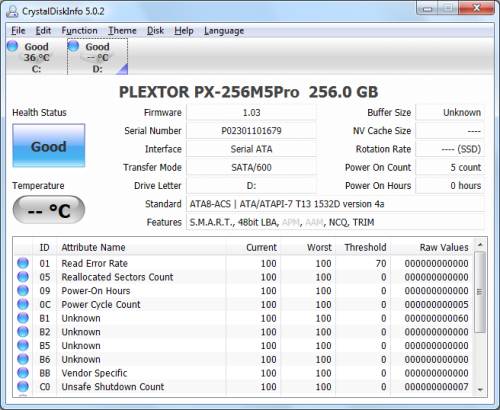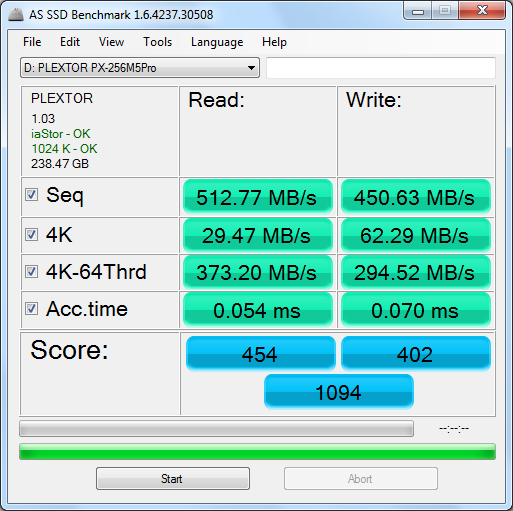TRIM and True Speed:
While SSD's offer many benefits, there are some downsides to using flash memory. One of the biggest issues people run into is performance degradation. Over time, an SSD will run out of fresh blocks and will have to write over data the file system has marked as deleted. This procedure is very complicated and can slow an SSD's write speeds considerably.
To fix this problem, most manufacturers have added TRIM support to their SSDs. The TRIM command allows an operating system, such as Windows 7, to tell an SSD which data blocks are no longer in use. Using this information, the drive pro-actively erases these blocks and adds them to the free block pool.

The M5Pro Xtreme is the latest drive to ship with their Plextor's exclusive True Speed technology. By leveraging the power of advanced firmware, True Speed ensures that the SSD works at its full potential even after extensive use and long periods of operation. Along with support for TRIM, the M5Pro Xtreme's firmware incorporates Plextor's Bad Block Management, Global Wear Leveling and Instant Restore technologies. Where Bad Block Management and Global Wear Leveling optimize the way data is written on the drive, Instant Restore maintains "like new" performance by reorganizing data to maximize the number of free cells.
Plextor's True Speed technology works very well, as I saw very little performance degradation, even after hours of testing. I was finally able to overwhelm it by using Iometer to fill the entire drive and then running a random write test for 30 minutes. This had little impact on the PX-256M5Pro Xtreme's read speed. However, its average writing speed dropped to 31.0 MB/s when in this "dirty" state.

PX-256M5Pro Xtreme - Dirty
I let the computer sit for a few hours and then reran the test. Looking at the screenshot below, you can see that the PX-256M5Pro Xtreme's average write speed had increased to a mere 37.4 MB/s. Needless to say, this was not the result I expected, especially when you consider how well the original M5 Pro did in this test.

PX-256M5Pro Xtreme - After TRIM
I contacted Plextor regarding this issue and they pointed out that the M5Pro Xtreme uses a new garbage collection algorithm which can only partially restore the drive's performance. To fully restore the M5Pro Xtreme you need to trigger TRIM and, for whatever reason, this was not happening in our tests.
With this in mind, I went back and reran the test using AS SSD instead of HD Tach. AS SSD isn't as low level as HD Tach nor does it produce a nice looking graph. However, it does let us test a drive's read and write speeds without having to delete the volume. Once again, I used Iometer to fill the PX-256M5Pro Xtreme and put it into a "dirty" state. This had very little effect on the drive's read speed. However, its sequential write speed dropped to 46.94 MB/s

PX-256M5Pro Xtreme - Dirty
I let the computer sit for about 30 minutes and then reran the test. Looking at the screenshot below, you can see that the PX-256M5Pro Xtreme's average write speed had increased to 437.72 MB/s.

PX-256M5Pro Xtreme - After TRIM
Lastly, I used Plextor's Plextool software to perform a secure erase of the PX-256M5Pro Xtreme. With the drive wiped clean, it had average read and write speeds of 512.77 MB/s and 450.63 MB/s, respectively.

PX-256M5Pro Xtreme - Secure Erase
Final Thoughts:
On the surface, the M5Pro Xtreme may seem more evolutionary than revolutionary, but Plextor's engineers have put a lot of effort into this upgraded version of the M5 Pro. Along with the recently released Xtreme firmware, the M5Pro Xtreme uses a newly engineered and redesigned PCB board that combines Marvell's 88SS9187 controller with Toshiba’s latest 19nm Toggle Mode MLC NAND flash. As you'd expect, this combination produced some impressive performance numbers. In our sequential read and write tests, the PX-256M5Pro Xtreme was able to read at speeds as high as 558 MB/s and write at speeds in excess of 436 MB/s. It also did reasonably well our random write tests, producing more than 63,000 IOPS at low queue depths. Increasing the queue depth did lead to better results. However, the M5Pro Xtreme still had a hard time keeping up with the latest offerings from OCZ and Samsung.
The M5Pro Xtreme is available now in 128GB, 256GB and 512GB capacities. Prices on Amazon.com currently range from $129 up to $464, with the 256GB version reviewed here going for about $240.

Highs:
- True Speed technology
- Available in 128GB, 256GB and 512GB capacities
- Excellent sequential read and write speeds
- Very good random read performance
- Performs equally well with compressible and incompressible data
- Consistent performance, even after intensive usage
- SATA 6Gb/s interface
- Toggle Mode NAND flash
- Large DRAM cache
- Exclusive firmware with Instant Restore, Global Wear Leveling and Bad Block Management
- True-Protect double-data protection technology
- 256-bit AES encryption
- Supports TRIM, SMART and NCQ
- Ultra-slim form factor
- Includes a 2.5" to 3.5" adapter bracket
- Includes NTI SSD Utility Suite
- 5 year warranty
Lows:
- Random write performance at low queue depths could be better
- Pricey

